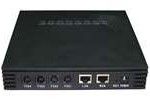 It shouldn’t be a surprise that residential customers of incumbent phone companies have either moved to “wireless only” or are taking advantage of lower-priced VoIP-based carriers (often offered by the “other incumbents” like meaning cable companies or IP-Telephony specialists). Over on the Internet2go.net site, Greg Sterling posted these comments:
It shouldn’t be a surprise that residential customers of incumbent phone companies have either moved to “wireless only” or are taking advantage of lower-priced VoIP-based carriers (often offered by the “other incumbents” like meaning cable companies or IP-Telephony specialists). Over on the Internet2go.net site, Greg Sterling posted these comments:
The US telephone market is more diverse and complex today than at any time before. To that point the US FCC recently reported a fairly dramatic piece of data: almost 20% of US residential landlines are now VoIP-based.
According to the press release associated with the release of the FCC "Local Telephone Competition" report:
- At year-end 2008, there were 141 million traditional switched access lines in service and 21 million interconnected VoIP subscriptions in the United States, or about 162 million wireline retail local telephone service connections in total. Of these, 97 million were residential connections and 65 million were business connections.
- Of the 162 million total connections, 48% were residential switched access lines, 39% were business switched access lines, 12% were residential VoIP subscriptions, and 1% were business VoIP subscriptions.
- Of the 97 million wireline residential connections, 74.5% were ILEC switched access lines, 19.5% were non-ILEC interconnected VoIP subscriptions, 5.8% were non-ILEC switched access lines, and 0.3% were ILEC interconnected VoIP subscriptions.
These data are from 2008 so they're bound to be different now. The VoIP penetration might be as much as 5 points higher today.
The vast majority of US residential VoIP subscribers (81%) receive VoIP as part of a "broadband bundle." This is primarily cable companies offering discounted packages of Internet, TV and telephone together. This is part of a larger cable strategy to retain subscribers and steal voice revenues from rival telcos.
Over time more residential calling will move to lower-cost VoIP or wireless plans. However, the move toward tiered pricing could affect consumer behavior accordingly. Today, according to the US CDC, 25% of US households have no landline at all.
The migration to IP-telephony should be unremarkable, except to say that, once “plain vanilla” voice moves to the cloud, it can be treated like any other stream or data file. Thus customers have learned that they can capture conversations (or voice messages) as audio files, attach them to emails and forward them or “share” them much as they would any MP3. With the help of services like Google Voice, customers are incorporating their home phone numbers into personal “find me/reach me” schemes that can be set up more easily than ever before.
The next steps will be to augment their voice conversations with more robust renditions of “CallerID”, which can include photos or other images, status messages, location indicators and recent check-ins, tweets or newsfeeds. Said steps will take place in the undetermined future, in that the migration has largely been for cost savings purposes. Still, the idea that one-out-of-five of the homes you pass in the U.S. are “talking over the Internet” should spur some developer and applications providers creative energy.
Categories: Articles

 NiCE Interactions 2025: Agentic AI, Better Data, and a Whole Lot of Partnership
NiCE Interactions 2025: Agentic AI, Better Data, and a Whole Lot of Partnership  Getting It Right: What AI Agents Actually Mean for Customer Support (Webinar)
Getting It Right: What AI Agents Actually Mean for Customer Support (Webinar)  Beyond the Basics: How AI Is Transforming B2B Sales at TP
Beyond the Basics: How AI Is Transforming B2B Sales at TP  Five9 Launches Agentic CX: Toward AI Agents That Reason and Act
Five9 Launches Agentic CX: Toward AI Agents That Reason and Act